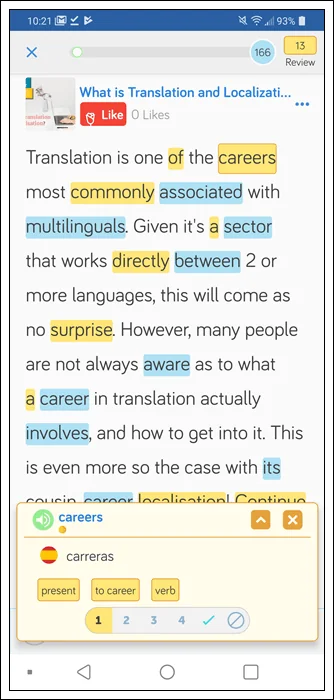Types of Verbs in English: The Ultimate List
It makes more sense to define a verb by what it does than what it is. This is the reason why there are so many types of verbs in English. Depending on where you look, that list might include three, five or more types. In this post, we’ll break down all of them.
To truly understand all the types of verbs in English, let’s first answer these two key questions:
What Are Verbs? vs. What Are the Functions of Verbs?
By definition, verbs are words that describe the action (what the subject is doing) in a sentence. For example, in the sentence ”He eats pizza every day.”, eats is a verb.
Verbs in English can have multiple functions, for example:
– to describe an action: I play football.
– to express a state: She thinks of him every day.
– to complement other verbs: He may do it. (may + do)
– to connect the subject of a sentence to a noun or objective: Lara is in love with Jim.
– to make friends with prepositions and create phrases: turn up, take off, put on, etc.
As we can see, the different types of verbs in English are determined by the function of those verbs in a sentence, their relationship to other words in a sentence or the combination of verbs and prepositions to make cool new words.

What Are the Main Types of Verbs in English?
The big question: what is the exact number of the English verb types? The best answer is four. This answer can also be a higher number, as some of these main verb types also have subtypes, all of which are covered in detail below.
Action Verbs
This particular verb type is one of the more prominent ones in English. It’s interesting that some linguists would argue that this isn’t just one verb type but two or even three. You see, actions can be both physical and non-physical. As such, they can be classified as: action, state, and mental verbs.
Let’s make things easier and just call all of them action verbs. Essentially, even if you’re not doing something physically, you’re still doing it, you know?
Now, if you really want to make that distinction, you could perhaps say that there are active and stative verbs in English. Here are some examples:
– Active verbs: to eat, to drink, to drive, to hold, to run, to stand, to smile, etc.
– Stative verbs: to sleep, to disagree, to think, to wonder, to doubt, to want, etc.
Transitive vs. Intransitive Verbs
Action verbs that are followed by objects are called transitive verbs. In other words, if there is an object in a sentence that receives the action of the main verb, that verb is called transitive (for example, Jasmin is reading a book).
Transitive verbs can have either a direct or an indirect object. Let’s take a look:
Becky raises her hand. (transitive verb with a direct object: the direct object is her hand.)
Sarah is giving Haris a pen. (transitive verb with an indirect object: the direct object is a pen; the indirect object is Haris).
Intransitive verbs are never followed by an object, whether direct or indirect. They can be followed by an adverb or adverbial phrase but there is never an object to receive the action, for example:
Belma is walking slowly to the restaurant. (The phrase slowly to the restaurant modifies the verb but there is no object to receive the action.)

Linking Verbs
Linking verbs connect (or link) the subject of a sentence to a noun or adjective that describes that subject. That noun or adjective is called the subject complement. Here are some examples:
I am a student.
Kenneth became a business major.
These kids grow older by the day, don’t they?
The most common linking verb in English is the verb to be in all its forms (am, are, is, was, were, been, etc.). Other verbs that are frequently used as linking verbs are: to become, to sound, to feel, to grow, to smell, to remain, to look, etc.
Note: Linking verbs are usually inactive verbs. They describe the state of being (like) something. As such, you are highly unlikely to find any action verbs (covered in the previous section) behaving as linking verbs.
Helping Verbs
Helping verbs are just that – they help the main verb in describing a particular action which otherwise wouldn’t have the same meaning. They are used before action or linking verbs to convey additional information surrounding aspects of possibility (may, might, could, etc.) or time (is, did, has, etc.).
Note: Helping verbs are also commonly referred to as auxiliary verbs.
There are only three main auxiliary verbs in English: be, do, and have (in all of their forms). Before you ask – yes, these can also be used as linking verbs but then, their function is different.
Jenny is having a party. (auxiliary verb is + main verb having)
Jenny is a party girl. (action verb is + subject complement a party girl)
The remaining helping verbs are called modal verbs. Modal verbs in English are: can, could, may, might, will, would, shall, should, and must. Let’s take a look at some examples of all of them:
I can do a backflip.
Could you do me a favour?
May I go out, please?
It might rain outside.
Will you go to prom with me?
I would do anything for you!
We shall sit down before the teacher comes in.
We shouldn’t do this here.
All of you must complete the assignment.

Phrasal Verbs
Phrasal verbs are, in fact, a combination of verbs and prepositions such as: on, off, up, down, in, out, etc. that create entirely new verbs with meanings , for example:
to put (action verb: to place something in a particular position)
to put off (phrasal verb: to delay or move an activity to a later time)
The interesting thing about phrasal verbs is that each individual preposition is likely to create an entirely new verb with a new meaning (or several new meanings), even if the root verb used in the phrase is exactly the same. Again, here’s an example of this with the main verb put:
to put on (to start wearing, to host or to gain weight)
to put aside (to save for later or to ignore something negative temporarily)
to put away (to send to prison or to leave something in its usual location)
to put back (to postpone or to return something to its usual location)
to put down (to humiliate, to write down, to kill or to leave a deposit)
to put in (to submit a request or to devote time and effort)
The list of phrasal verbs with put just goes on and on… In a nutshell, phrasal verbs are pure fun! As you can see, they are one of the best ways to learn new English words and practice English by using vocabulary in context.
Bonus: Irregular vs. Regular Verbs
There are actually two more types of verbs in English – regular and irregular verbs. However, these two aren’t necessarily part of the list above. They are more verb forms rather than types.
In simpler terms, any verb in English (regardless of its function in a sentence) is either regular or irregular by nature. As such, verbs can have different forms in different tenses, for example:
– The verb click is a regular verb and can have the following forms: click, clicks, clicking, clicked. That’s it.
– The verb eat is an irregular verb and can have the following forms: eat, eats, eating, ate, eaten. One cannot say eated, as the suffix -ed is usually added to regular verbs only.
We’ll be taking an in-depth look at the differences between regular and irregular English verbs (with lots of samples) in an upcoming article.
Pro Tip: Master Types of English Verbs with LingQ!

Take your English practice on the go! Download the LingQ mobile app now (available for both Android and iOS). Import any online content into your lessons and learn English with the content you love.
Until next time, happy learning, everyone!
***
Jasmin Alić is an award-winning EFL/ESL teacher and writing aficionado from Bosnia and Herzegovina with years of experience in multicultural learning environments.


